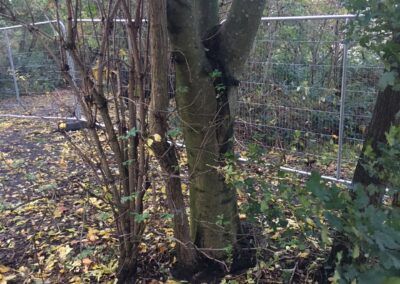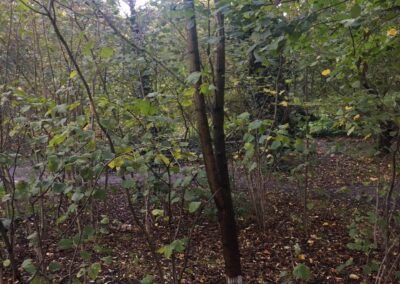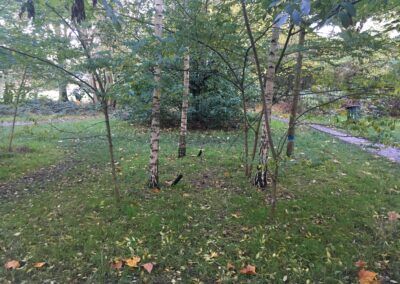Robinia pseudoacacia
Battersea Woods has become invaded by the super-suckering North American invader – False acacia (Robinia pseudoacacia).
The most westerly tip of the woods (next to the changing rooms) has the most chronic invasion but the invasion remains at its worst for the first half of the woodlands moving eastwards from this point.
The woodlands are now at a critical juncture regarding the future of our native flora and now is the time where difficult decisions may need to be made.
Multiple studies refer to this tree as a light-demanding, pioneer that is dramatically reducing the biodiversity of indigenous woodlands, from its tendency to suckering and shading, throughout the UK and Europe.
In Battersea Woods, False acacia has now penetrated glades of Hazel (Corylus avellana), Ash (Fraxinus excelsior), Silver Birch (Betula pendula) and is chronically shading many other woodland species particularly the larger Blackthorn trees.
How we manage the current invasion will determine the future flora of the woodland.
We have choices.
We can do nothing and let the clock roll forward 10-20 years and live with the acceptance that False acacia will be our new dominant species and perhaps start to bid farewell to many of our longstanding woodland favourites.
Or we can take action.
False acacia is a tricky tree to tackle for a number of reasons. It has evolved to respond to mechanical injury from cutting or coppicing by producing numerous suckers in all directions from the main stem. The more you cut it, the more it suckers – think the ‘Sorcerer’s Apprentice’.
A close examination of the woodland floor reveals numerous examples of where this has already been the case – a main Robinia trunk or stem that has been cut followed by multiple resultant suckers nearby.
Once these suckers have become established, further removal will again produce multiple suckers if cut or coppiced.
This is why Robinia has become such a successful coloniser throughout Europe. The more I read about it, the more it reminds me of a tree version of Japanese Knotweed – which is why Robinia is now on the list of top 100 invasive species.
Studies show the most effective methods for control combine mechanical removal (by felling) with herbicide treatment (glyphosate) to the stump once the sapling has been felled. This kills the root system and prevents it from producing its signature suckers.
Given the new green world we are all so very keen to bring about, the word ‘glyphosate’ is possibly one of the most emotive. For those of you unfamiliar with the term, glyphosate is the active ingredient in ‘Round-Up’ – the off-the-shelf weedkiller you can buy in B&Q or Homebase to spray the dandelions coming through your paving.
Its use in the woods appears to run contrary to everything we are fighting for and is emblematic of an agricultural and weed control management system we are so desperate to leave behind.
And I would include myself in that category. In my 25 years of landscaping and horticulture, I have always aspired to be the greenest of gardeners and have only used glyphosate in maybe a dozen cases. My gardening store cabinets have no chemical canisters idling within waiting to be sprayed or applied.
But sometimes we find ourselves completely cornered by tricky situations where biological solutions and sheer physical effort will not bring about the greenest of resolutions.
Japanese Knotweed certainly falls into this category as does a large Sycamore stump destined to re-sprout with scores of new shoots the following spring if left untreated.
It is also a case to consider where it will do more harm to the surrounding plants to try to mechanically remove a large invasive specimen than it is to apply a specifically and carefully targeted herbicide.
A large scale effort to just mechanically ‘lift’ the Robinia from the ground would seriously damage the root systems of surrounding shrubs and trees. It would probably still leave some Robinia roots intact that would regrow – and Robinia is an excellent coloniser of ‘disturbed’ ground – again, giving it the edge.
I know everyone recoils at the thought of employing chemical treatments but, when used sparingly and judiciously, and targeted very precisely, they can be far and away from the most effective method in terms of cost, labour, minimising disruption to the forest floor and damage to neighbouring species.
The current suckering invasion of Robinia falls into this last category. We are somewhat trapped. If we do nothing, the Robinia will slowly continue to spread through the woods threatening our native species. If we try to dig it up we will destroy the root systems of all the established surrounding plant life and cause it to sucker. So this may well be one of those rare situations where its use is warranted.
There may be around 20 semi-mature and sapling Robinia trees where this treatment might be appropriate.
Lambeth currently has a policy of not using glyphosate for routine treatment for weeds in the form of spraying. However, this is a far cry from routine treatment and the methodology and mode of application here would be completely different from spraying chemicals into the air.
Many companies (inc. Pro Green) now manufacture Ecoplugs. These are small plastic capsules that are hammered into the cambium layer of the trunk immediately after the tree has been felled. It is a self-sealing capsule that protects wildlife and keeps all active glyphosate within the tree trunk until it has degraded.
However, in order for it to be most effective, it needs to be applied to the stump within 48 hours of the cut – otherwise, it may not work.
If the felled Robinia trees are not treated, they will continue to sucker. In fact, it may well be better not to cut them at all if glyphosate capsules are not going to be used.
There is a huge push right now for designing new planting plans for the woodlands, which is very exciting. We are hoping to genuinely improve the biodiversity of the woodland flora, inc. ground cover, shrubs and trees. It is for this very reason that the time has come to develop a serious and effective Robinia management strategy.
There may be little point devising wonderful plans and purchasing new trees and shrubs to restore our native woodland if the whole woods are to be slowly engorged by Robinia.
I’m sure Extinction Rebellion members of the satellite groups may feel deeply troubled at the suggestion being made but I would ask them to look into their own green hearts and summon the rebellion against the extinction of our own native species – even Isabella Tree on the Knepp Wildlands estate sprayed whole fields with glyphosate twice in one year in order to start her Weald wildflower mix (Tree. I. Wilding. 2018 p.45) and we are not suggesting anything like this.
For any remnants of the Robinia that survive treatment, there is one encouraging study (Stone. Katherine R. Robinia pseudoacacia. 2009 USDA Forest Service) that shows intense grazing by goats is effective at killing Robinia 75-100% after four years.
This might be something that can be mimicked by our volunteers (no, not literally) but by repeatedly cutting back any remaining regrowth with secateurs.
At this point, it is strongly advised that AGA Group do not prune or ‘top’ any of the remaining larger Robinia trees that are staying in the woods or to remove any smaller trees until a clear management strategy has been agreed and approved.
This situation also casts a long shadow over the plan to open up the canopy through much of the woodland as such a move will directly favour the rapid Robinia growth over the growth rate of our own native species.
As a secondary consideration, it might also be beneficial to grow English Ivy (Hedera helix) up the remaining large Robinia trunks to slow future growth and reduce crown spread. In time, this would have the added advantage of providing nesting sites for birds and producing end of season nectar for insects.
It’s not all bad news. The wood cut from suckers and young saplings could be put to great use by defining new pathways through the woods as it is a tough, rot-resistant wood and would be ideal for this purpose.
This is admittedly a depressing situation but, without proper control of the spreading Robinia, all optimistic future plans for replanting the woodland may well be deeply flawed and simply unobtainable.
Whatever the conclusion of the CCMAC meeting, it is essential that it is not based on emotional reactions and is primarily considered with long-term ecology and conservation in mind.
The need for a future management strategy
The majority of the larger Robinia stands (with multiple trunks) are mainly on the northern edge of the woods, along the path between the bandstand and the changing rooms. These really are too large and established to be included in any strategy and are also a key part of the landscape.
However, there is a strong case for Robinia control and removal when moving towards the interior of the woodland where there are increasingly single-stemmed specimens with smaller diameters inc. those that are invading the groves of Ash, Birch and Hazel.
Any future management strategy needs to focus on protecting the interior from the spread so these areas can be replanted with native trees and flora without being encroached upon by future spread.
There is an urgent need to develop a possible action plan that can be agreed with Lambeth, and the respective satellite groups, to contain the spread within its current limits.
This could include:
- to devise and implement a Robinia management control strategy to protect the interior of the woodland and to prevent further spread into the surrounding grassland
- acceptance that the larger, multi-stemmed specimens lining the path are important and are to be retained but to consider removal and possible glyphosate treatment of smaller specimens in the interior especially those invading groves of native trees (see photos below)
- ongoing, intense and repeated cutting back of all new regrowth from suckers by volunteers and Lambeth parks management – this would need to be done very regularly but appears to be successful at exhausting suckers within 4 years
- agreement with Lambeth to replace lost Robinia specimens with new native trees – funds may also include contributions from joint ventures between Friends of Clapham Common and Clapham Society etc.
- future woodland management commitment from Lambeth not to prune the larger specimens and take all measures to avoid future suckering
- all cut wood to be reused in the woods for lining paths and mulch
- commitment to creating biodiverse, wilded, shrub and tree ‘islands’ within the woods to suppress Robinia regrowth and create year-round, cover and habitats for wildlife.
Additional concerns that need to be addressed.
- Suckers from Robinia can emerge more than 50ft away from the parent tree. It is in Lambeth’s best interest to protect the surrounding grasslands as Robinia colonises these areas very quickly. The photographs below (taken today) already shows that Robinia is now moving into the grasslands between the woods and the bandstand. This should be of major concern as these areas are in the ‘ecological core’ (Masterplan 2007) and the grass here is not mown regularly.
- Robinia is a member of the family of legumes (Fabiaceae) like peas and beans, which means it fixes its own nitrogen. The ongoing effect of increased nitrogen-fixing in the soil favours cellulose growth over root development meaning trees grow taller quicker but may have weaker root systems. This does not bode well if the spread of Robinia were to cross the woodland floor and reach the large London plane trees (Platanus x acerifolia) lining The Avenue.
References:
Michaela Vitkova et al. Black locust (Robinia pseudoacacia) beloved and despised: A story of an invasive tree in Central Europe. Forest Ecology and Management. Vol. 384, 15th Jan 2017 pp287-302
Lazzaro L. et al. How ecosystems change following invasion by Robinia pseudoacacia: Insights from soil chemical properties and soil microbial, nematode, microarthropod and plant communities. Science of The Total Environment. Vol. 622-623. 1st May 2018. pp. 1509-1518
Benesperi R. et al. Plant diversity is threatened by Robinia pseudoacacia L. (Black Locust) invasion. Biodiversity and Conservation 21. (14): pp. 3555-3568. December 2012
Hanzelka J. et al. Responses to the black locust (Robinia pseudoacacia) invasion differ between habitat specialists and generalists in Central European forest birds. Journal of Ornithology. Vol. 156 pp. 1015-1024. 2015
Von Holle B. et al. Ecosystem legacy of the introduced N2-fixing tree Robinia pseudoacacia in a coastal forest. Oecologia 172, 915–924. 2013
Slabejova D. et al. Comparison of the understory vegetation of native forests and adjacent Robinia pseudoacacia plantations in the Carpathian-Pannonian region. Forest Ecology and Management. Vol. 439 pp. 28-40. 1st May 2019
Sadlo J. et al. Towards site-specific management of invasive trees based on the assessment of their impacts: the case of Robinia pseudoacacia. NeoBiota 35: 1-34
Pergl J. et al. Don’t throw the baby out with the bathwater – ban of glyphosate use depends on context. NeoBiota 56: 27-29. 23rd April 2020
Liegel, K., R. Marty, and J. Lyon 1984. Black locust control with several herbicides, techniques tested (Wisconsin). Restoration and Management Notes 2(2):87.
Invasive species – Best control Practices. Black Locust (Robinia pseudoacacia). Michigan Dept. of Natural Resources 2/2012.
Ontario Invasive Plants: Black Locust (Robinia pseudoacacia L.) Management Technical Document for Land Managers. March 2017
Illinois Natural History Survey. Vegetation Management Guide – Black Locust (Robinia pseudoacacia L.)
Weed Control Handbook. A Weed Report US. Robinia pseudoacacia L. Black Locust. 2013




